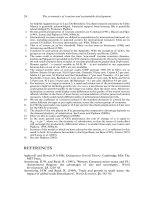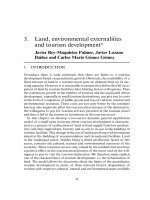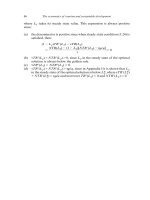THE ECONOMICS OF MONEY,BANKING, AND FINANCIAL MARKETS 402
Bạn đang xem bản rút gọn của tài liệu. Xem và tải ngay bản đầy đủ của tài liệu tại đây (36.15 KB, 1 trang )
370
PA R T I V
The Management of Financial Institutions
below the exercise price, the losses will be small because the owner of the
call option will simply decide not to exercise the option. The possibility of
greater variability of the underlying asset as the term to expiration lengthens
raises profits on average for the call option.
Similar reasoning tells us that the put (sell) option will become more valuable
as the term to expiration increases because the possibility of greater price variability of the underlying financial instrument increases as the term to expiration
increases. The greater chance of a low price increases the chance that profits on
the put option will be very high. But the greater chance of a high price does not
produce substantial losses for the put option because the owner will again just
decide not to exercise the option.
Another way of thinking about this reasoning is to recognize that option contracts have an element of heads, I win; tails, I don t lose too badly. The greater
variability of where the prices might be by the expiration date increases the value
of both kinds of options. Since a longer term to the expiration date leads to greater
variability of where the prices might be by the expiration date, a longer term to
expiration raises the value of the option contract.
The reasoning that we have just developed also explains another important fact
about option premiums. When the volatility of the price of the underlying asset is
great, the premiums for both call and put options will be higher. Higher volatility
of prices means that for a given expiration date, there will again be greater variability of where the prices might be by the expiration date. The heads, I win; tails,
I don t lose too badly property of options then means that the greater variability
of possible prices by the expiration date increases average profits for the option
and thus increases the premium that investors are willing to pay.
Summary
Our analysis of how profits on options are affected by price movements for the
underlying asset leads to the following conclusions about the factors that determine the premium on an option contract:
1. The higher the strike price, everything else being equal, the lower the
premium on call (buy) options and the higher the premium on put (sell)
options.
2. The greater the term to expiration, everything else being equal, the higher the
premiums for both call and put options.
3. The greater the volatility of prices of the underlying asset, everything else
being equal, the higher the premiums for both call and put options.
The results we have derived here appear in more formal models, such as the
Black-Scholes model, which analyze how the premiums on options are priced.
You might study such models in other finance courses.
SWAPS
In addition to forwards, futures, and options, financial institutions use one other
important financial derivative to manage risk. Swaps are financial contracts that
obligate each party to the contract to exchange (swap) a set of payments it owns
for another set of payments owned by another party. There are two basic kinds
of swaps: Currency swaps involve the exchange of a set of payments in one
currency for a set of payments in another currency. Interest-rate swaps involve the
exchange of one set of interest payments for another set of interest payments, all
denominated in the same currency. We focus on interest-rate swaps.









